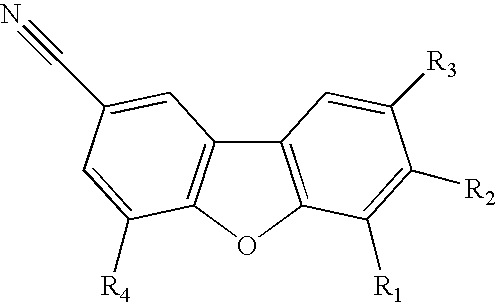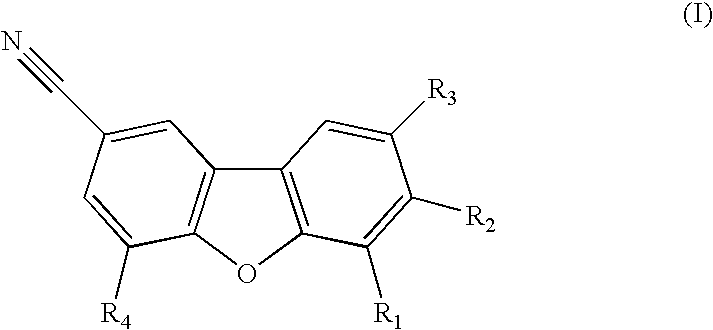Use of progesterone receptor modulators
a progesterone receptor and modulator technology, applied in the field of use of progesterone receptor modulators, can solve problems such as increasing the risk of uterine cancer
- Summary
- Abstract
- Description
- Claims
- Application Information
AI Technical Summary
Problems solved by technology
Method used
Image
Examples
example 1
7-methoxydibenzo[b,d]furan-2-carbonitrile
A. 4-(2-bromo-5-methoxyphenoxy)benzonitrile
[0084] A mixture of 4-(3-methoxyphenoxy)benzonitrile (Sawyer, J. Scott; Schmittling, Elisabeth A.; Palkowitz, Jayne A.; Smith, William J., III. Journal of Organic Chemistry (1998), 63(18), 6338-6343) (1.39 g, 6.17 mmol) and N-bromosuccinimide (1.21 g, 6.79 mmol) in acetonitrile (30 mL) was stirred at room temperature for 24 h. The solution was poured into a mixture of 50 mL diethyl ether and 50 mL water, the organic layer was washed with brine, dried over magnesium sulfate, and concentrated. The residue was purified by silica gel column chromatography (hexane / ethyl acetate, 95 / 5 to 90 / 10) to afford a mixture of 4-(2-bromo-5-methoxyphenoxy)benzonitrile and 4-(4-bromo-3-methoxyphenoxy)benzonitrile which was further purified by reversed-phase preparative liquid chromatography (water / acetonitrile) to afford 4-(2-bromo-5-methoxyphenoxy)benzonitrile (0.99 g, 53%) as an orange oil.
B. 7-methoxydibenzo[b,d...
example 2
7-hydroxydibenzo[b,d]furan-2-carbonitrile
[0087] A mixture of 7-methoxydibenzo[b,d]furan-2-carbonitrile (50 mg, 0.22 mmol) [Example 1] and pyridine hydrochloride (388 mg, 3.4 mmol) was heated in a sealed tube at 185° C. for 3 h. The mixture was cooled, diluted with water, neutralized with aqueous sodium hydroxide, and extracted twice with ethyl acetate. The combined organic layers were washed with brine, dried over magnesium sulfate, and concentrated. The residue was purified by silica gel column chromatography (hexane / ethyl acetate, 90 / 10 to 80 / 20) to afford 7-hydroxydibenzo[b,d]furan-2-carbonitrile (32 mg, 68%) as a white solid.
[0088] mp 270-271° C.; MS (ESI) m / z 208; HPLC purity: The major component is 98.4% at 210-370 nm window; and 96.8% at 240 nm@max. abs. RT=9.0 min; Xterra RPI 8, 3.5u, 150×4.6 mm column, 1.2 mL / min, 85 / 15-5 / 95 (Ammon. Form. Buff. pH=3.5 / ACN+MeOH) for 10 min, hold 4 min.
example 3
6-bromo-8-fluoro-7-hydroxydibenzo[b,d]furan-2-carbonitrile
[0089] A solution of 8-fluoro-7-hydroxydibenzo[b,d]furan-2-carbonitrile (0.790 g, 3.48 mmol) and N-bromosuccinimide (0.492 g, 4.17 mmol) in anhydrous tetrahydrofuran was stirred under a nitrogen atmosphere at room temperature for 10 min. The solvent was evaporated and the residue purified by silica gel column chromatography (hexane / ethyl acetate, 9 / 1 to 1 / 1) to afford 6-bromo-8-fluoro-7-hydroxydibenzo[b,d]furan-2-carbonitrile (0.600 g, 56%) as a white solid.
[0090] mp 270° C. (dec); MS (ES) m / z 303.9; HPLC purity: no impurities detected at 210-370 nm window; and no impurities detected at 300 nm@max. abs.; Xterra RPI 8, 3.5u, 150×4.6 mm column, 1.2 mL / min, 85 / 15-5 / 95 (Ammon. Form. Buff. Ph=3.5 / ACN+MeOH) for 10 min, hold 4 min. HRMS: calcd for C13H5BrFNO2—H+, 303.94149; found (ESI, [M-H]−), 303.94.
PUM
| Property | Measurement | Unit |
|---|---|---|
| time | aaaaa | aaaaa |
| temperature | aaaaa | aaaaa |
| temperature | aaaaa | aaaaa |
Abstract
Description
Claims
Application Information
 Login to View More
Login to View More - R&D
- Intellectual Property
- Life Sciences
- Materials
- Tech Scout
- Unparalleled Data Quality
- Higher Quality Content
- 60% Fewer Hallucinations
Browse by: Latest US Patents, China's latest patents, Technical Efficacy Thesaurus, Application Domain, Technology Topic, Popular Technical Reports.
© 2025 PatSnap. All rights reserved.Legal|Privacy policy|Modern Slavery Act Transparency Statement|Sitemap|About US| Contact US: help@patsnap.com



